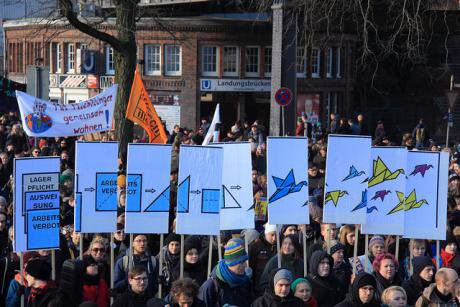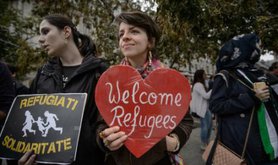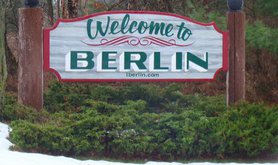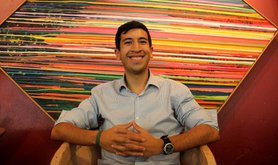
Lampedusa in Hamburg unites groups from the "Right to the City" network, refugees, trade union activists, student organisations around call, "Right to the City - Never mind the papers!",Germany 2015. Flickr/Rasande Tyskar. Some rights reserved.A new municipal protagonism appears to be emerging in the so-called refugee ‘crisis’. City governments are supporting one another in welcoming refugees, contesting state blockages in parliaments and making agreements between cities. In April 2016, ten European cities jointly denounced the inaction of states in the welcoming of refugees in the European Commission. Demanding that cities be seen as key political actors of welcoming, and appealing for direct EU funding to cities, mayors such as Ada Colau (Barcelona) are exploring ways of circumventing the national deadlock in the current crisis.
What role can and do states, the EU and cities play in producing, managing and overcoming this crisis? How might networks of ‘cities of refuge’ develop sustainable practices of social composition beyond the politics of identity? The role of solidarity movements in cities is key: these movements have opened the space for demands and imaginaries of a different Europe open to solidarity. We ask how municipalities and locals can help break the deadlock and negative spiral of EU and national refugee policy, and argue that the time is ripe for grassroots and government practices to be articulated critically, starting from the city.
A new horizon for translocal solidarity?
Looking at the media, one can easily get the impression that there is an unchallenged European-wide consensus about shutting the borders. But millions of Europeans have been actively involved in refugee solidarity work - in Germany alone the estimated number is 11 million. The far right may indeed be growing, but the media and political elites are ignoring the existence of a popular alternative to the current politics of closure. The media and political elites are ignoring the existence of a popular alternative to the current politics of closure.
However, appeals to the EU and its member states have not stopped the headlong rush into the dead end of closed borders and the EU-Turkey deal. People in Europe who are building an open Europe in solidarity are also showing their states what kinds of societies they want to live in. But the response by both states and EU has been disappointing. These levels are currently blocked as opportunities for action and imaginaries of change. So whence might a horizon of translocal solidarity emerge to break the deadlock?
The city is an essential terrain of struggle, and it is hard to imagine substantial change on the level of nation states and the EU without the production of a culture of solidarity in the everyday life of cities and towns. Drawing on their social, relational, infrastructural and institutional wealth and diversity, cities can be the starting points not only for an embodied politics of everyday solidarity, but also for new municipal policies. The many and ever-changing collective subjects that define our cities go a long way in signalling what welcoming, openness, solidarity and diversity mean on the ground. It is at this level that we should look for solutions to the EU and state deadlock around the arrival of refugees and migrants, and rethink citizenship.
The EU and nationalism
The EU was sold as a project of cosmopolitan solidarity, presented as the overcoming of the divisions of Europe's nationalist past. But over recent years, the reality of the EU has been the exact opposite.
The euro-crisis has revealed an economic architecture that creates divergence between economies, impoverishing some, while undermining others. And the handling of the sovereign debt crisis in the southern periphery has revealed a will to sustain this architecture through direct domination. The imposition of the memoranda, the insertion of unelected technocrats as chiefs of state in Italy and Greece (Monti and Papademos), and the financial blackmail of Greece all confirmed the trend as the automated austerity of the "Growth-and-Stability Pact" has been imposed across the eurozone.
Also the refugee crisis is driving Europe towards fragmentation. While Merkel and German business saw the great influx of 2015 as a chance to replenish the country's aging workforce, a number of Germany's satellite states, such as Austria and Denmark, as well as the eastern European periphery, dug their heels in. The explicit or implicit boycott of the European relocation scheme by the aforementioned countries as well as Spain and France, is a case in point. Germany's forceful intervention in the name of the unity of an unsustainable setup has done nothing to reverse this European fragmentation, reinforcing the drive towards national selfishness.
The EU has always had a problem with creating a ‘warm’ European identity, a ‘we’ to give affective and lived meaning to the ostensible ideal of international solidarity. The narrative of a social and open Europe – always at odds with the EU's real practice of austerity, competition and deadly external borders – has finally died off in the refugee and euro crises of 2015.
The reality of the EU project has been widespread popular anxiety and fear for the future. And the blatant hollowness of its ideals has led to suspicion of this cosmopolitanism from above. In this situation it’s hardly surprising that many seek security and solidarity in the nation state. In this situation it’s hardly surprising that many seek security and solidarity in the nation state. In the crisis, the austerity politics of the EU and liberal state elites have turned European nation states into giant echo chambers for the nationalist right. In what follows, we will explore how cities can come into this situation to undo certain blockages and open new horizons for living together.
Dodging the border, across the metropolis and the town
The energy of people and communities – notably in cities – kept the state baffled for a while in autumn 2015. Powerful self-activating social solidarity, beyond the abstract notions of nation, citizenship or competitive scarcity, challenged state and EU narratives. Soon the latter reasserted their sovereignty via new strategies of divide and rule. Enter once again the politics of fear and the production of enemy images in public discourse, the activation of military means and questionable national alliances, as well as (legally questionable) half economic, half symbolic tricks (such as setting the upper limits for asylum claims, confiscating refugee’s belongings, measuring investment in refugees as foreign aid, withdrawal of refugee-related donations from NGO budgets).
But often, lived experiences and practices of solidarity stick with people more than does the politics of fear. Hundreds of families, flatshares, neighbours, neighbourhoods, organisations and collectives have kept up the work of caring and opening doors. Not just in European capitals but also in small municipalities, myriads of initiatives stay true to that moment of rupture in 2015, when Europe was open, was made open by people crossing borders and people welcoming them. A considerable part of this labour is done in cities and towns, by people without traditional activist profiles.
Municipal governments and the terrain of municipal politics can play a significant role in strengthening these horizons, practices and networks of solidarity, by affirming openness, providing resources and infrastructures for welcoming, and even practising municipal disobedience. An impressive example of the latter was provided by the Austrian village of Alberschwende, where the community and the mayor (actually from the conservative party) hid and defended asylum seekers in the face of the police who came to deport them (and even drafted a manifesto).
Networks of cities and the challenges of solidarity
Many European cities have been vocal about their commitment to welcoming refugees, often without much national or international visibility. From cities such as Berlin, Nantes, Leipzig, Ghent to villages such as Loos-en-Gohelle and Alberschwende, models for welcoming are developed together with inhabitants, often also in concert with regional administrations. Many of these are political experiments in their own right, with a view to transforming administration and governance. Expanding these alliances at a European level is key to unlocking the possibility of another Europe.
In September 2015 Barcelona’s mayor Ada Colau launched a call for the creation of a network of ‘Cities of Refuge’, co-signed by the Mayors of Paris, Lesbos and Lampedusa and later joined by many others across Europe, including Milan, Malmö, Wadowice. In March 2016, Barcelona, Lesbos, Lampedusa and Athens signed agreements to support one another in welcoming refugees, including an agreement to relocate 100 interested people from Athens to Barcelona.
At the level of EU and independent networks, cities have begun to make their voices heard on the need to welcome refugees, regardless of blockages put in their way by the state. At the April 5 meeting of cities at the European Commission, the mayors of Paris, Athens, Amsterdam, Berlin, Leipzig, Helsinki, Malmö, Rome and Ghent called for action. Expanding these alliances at a European level is key to unlocking the possibility of another Europe.
Such an expansion is not just a question of networks between the mayors themselves. It depends on a will to experimentation and knowledge-sharing, both on the level of solidarity movements and municipal institutions. And it requires the building of a political and social leverage that can force the states and the EU to live up to their responsibilities to the refugee conventions and to provide sufficient funding for the municipalities.
The living social fabric of cities makes openness sustainable
The city is a place of a lived and contested cosmo-politanism not limited by the idea or borders of Europe.
Cities and towns are the true ground on which people arrive and people meet, and if they become sites of good encounters, institutional experimentation and actual integration (as opposed to the current politics of forced assimilation), the legitimacy of the border and deportation regime will come under strain. Only where municipalities interact with and listen to their populations – from citizens to undocumented migrants – can sustainable models of ‘open’ and welcoming cities emerge. Town councils must encourage and enable people’s action and organisation without trying to control every aspect of them: making space for people to act.
Examples abound. There are countless municipal-supported experiments in linking inhabitants with newcomers, such as that of the Leipzig Refugee Council. Public and municipal institutions across Europe have introduced support schemes for refugees: universities such as Central European University Budapest, SOAS London or Warwick University have introduced special funds and scholarships and opened classes; student initiatives at SOAS, Malmö the UK student action for refugees network or the student-run law clinics in Hamburg, Leipzig, or Rome. Housing for refugees has been found through municipal call-outs and databases (in Vienna and Aarhus, for instance) as well as citizen and NGO platforms that connect newcomers with flatshares, such as German Flüchtlinge Willkommen or Room for Refugees in Scotland.
The city produces a sense of belonging as well as contestation over the common that relates to the everyday experience of commuting, working, going to school, living and paying your rent or mortgage. The city is where you recognize the truth of the imagined community of the nation: the heterogeneity of populations, professions and neighbourhoods, and the forms of cooperation, conviviality and contestation that come with it. Cities are where the abstract humanitarian desire to help the ‘other’ can be given substance through encounters, turning strangers into neighbours, comrades, co-workers, lovers…
Cities are where resources, relations and discourses become concrete and create worlds. Cities provide for newly arrived people with shelter, food, medical care, education. The question of resources is crucial. Poor cities hit by crisis and austerity easily become the sites of a zero-sum competition between ‘locals’ and migrants. In order not to divide their cities against themselves, city governments must take part in the fight against state and EU austerity and tax loopholes, and provide adequate funds for social services for their citizens – new and old.
As much as there have been attempts at pushing migrants and refugees out of the visibility of urban centres, to isolate them in remote camps, migration has always made it into the city. It is indeed a key part of the history of cities, of trade and travel, of the struggle over access to citizenship. As opposed to the EU’s abstract space of elite cosmopolitanism, the city is a space of conflictual negotiation between classes, of racist gangs and anti-racist self-defence, a space of reproduction and of encounters. The city is a place of a lived and contested cosmopolitanism not limited by the idea or borders of Europe.
If municipalities, local institutions such as schools and libraries, associations, and political groups actively welcome refugees, a great deal can be done to build conviviality, counter racist stereotypes and acknowledge the role of migration in the current context of global injustice and geopolitics. The city is a privileged terrain for the development of post-national subjectivity also because it is where tensions around citizenship and access have always played out.
Therefore it is crucial that municipalities, NGOs and newly formed support initiatives take past and present migration struggles into account, particularly those of migrant self-organisation, since they know best about the concrete problems of access and discrimination. To avoid refugees and migrants getting pitted against one another, or that different generations and classes of migrants become alienated from the new initiatives, there needs to be active dialogue across new and old movements. The time is ripe for evaluating welcoming initiatives across places and experiences, to develop them as durable and inclusive practices.
These tensions have their singular manifestations in different cities. In Barcelona for example, there is a mounting contradiction between the town hall’s failure to address the criminalization and police harassment that undocumented street vendors experience, and their vocal support for welcoming refugees. The possibility of a ‘solidarity city’ that’s more than a limited humanitarian programme strongly depends on the capacity to articulate different struggles and experiences of migration, within the bigger picture that is global neoliberalist capitalism today. In this sense, the time is ripe for evaluating welcoming initiatives across places and experiences, to develop them as durable and inclusive practices that can last beyond the current ‘crisis’ moment.
Rethinking citizenship beyond the state
In the metropolis, the question of 'citizenship' – a tool for defining who has access to what in a given territory – becomes very concrete. Doors open and close in people’s faces, streets and neighbourhoods are policed, tensions around poverty and exclusion play out. It's where access is defined not only by rights but also by actions, by everyday practices and relations, often by circumventing or dodging official policies, narratives or laws. Citizenship ought to be rethought from the real practices of cohabitation and solidarity that exist in the everyday life of neighbourhoods, especially poor and migrant ones. This is where ‘the global’ takes on meaning in relation to cohabitation and belonging. The current moment seems promising for redefining citizenship from below.
The current moment seems promising for redefining citizenship from below as well as from local governments and administration, in the cities. The right to the city too needs to be thought anew in this context. Stemming from struggles around land ownership and public space in cities, these point to the redefinition of who the subject of habitation is: do we think the city through the lens of citizenship or the autochthon, or indeed through the right to inhabit and the real contributions of people to reproducing daily life in the city? Everyone who lives here, is from here: new protocols and definitions of rights require a rethinking of the subject of rights. Cities might now experiment with alternative models.
The network of Sanctuary Cities in the US shows municipal models for guaranteeing rights through means other than citizenship. The model of the Sanctuary was born in the US in the late 1980s, when grassroots church networks and radical communities imagined and organised ways to welcome those fleeing from counter-revolutionary US interventions in central America: the access to housing rights, education and health as well as the possibility of working and of living in a community became the goal of large mobilisations that involved multiple cities all over the US.
Since the early 1990s these mechanisms of welcoming and of guaranteeing rights began to be regulated in local and later federal legal mechanisms. Firstly, by providing access to rights, as with the municipal laws in San Francisco that guarantee the right to public services, labour rights or a just trial, or with the New York ID card: a local ID card issued to any resident independent of immigration/citizenship status, valid in the face of police checks and granting discounts to transport and other municipal services. Secondly, by fighting at the federal level to regulate the legitimacy of city council and local counties in providing these services.
In a similar direction, many city governments in Europe are moving their pawns in the current situation, working to find routes and back routes to opening their cities to newcomers. These days we are witnessing a new movement of cities in Europe that actively seek to host refugees: they often do so by opposing the state and European Union. Many municipal and regional administrations have done their best to accommodate and welcome new people. Often in accordance with regional powers who play a key role too in providing the infrastructure of welcoming, cities are finding pathways for redefining themselves in relation not just to the state but also to the world.
If cities and urban movements begin to connect, a transeuropean municipalist movement is a clear possibility. Such a network offers a possible alternative to the failed internationalism of the EU, as spaces of concrete cosmopolitan solidarities join in an everyday production of citizenship through participation, collaboration and struggle.
With thanks to Franco Salvini for editorial comments
Read more
Get our weekly email






Comments
We encourage anyone to comment, please consult the oD commenting guidelines if you have any questions.